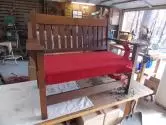Two Rules to Collect By

I don’t take many little journeys during the month of January, as next month’s Arts and Crafts Conference tends to fill all the time I have. This week the 88-page Conference Catalog goes to press, the canvas tote bags have to be ordered, the 2016 Arts and Crafts calendars get proofed, and your name badge forms keeping popping out of the fax machine and falling out my mail box, ready to be typed, proofed, printed, and filed.
But don’t misinterpret any of this as complaining on my part. After 27 years I know I won’t be snorkeling in January or nursing a nasty sunburn, but all that can wait until March. The Arts and Crafts Conference only happens once a year, and the excitement and enthusiasm you bring to the famed Grove Park Inn brings on a high better than anything you can buy in Colorado.
But on Sunday afternoon I closed my laptop, crept out of my office, and slipped out to my workshop, where a project has been patiently waiting for me. Last November, as I was driving across Indiana on my way back to visit my family in Illinois, I chose a random exit to fill up my gas tank. At the end of the ramp I spotted a sign advertising an antiques shop a mile away, and couldn’t think of any reason not to check it out.

Twenty-three gallons of gas and one Snickers bar later, I was stepping into a real antiques shop on a quiet town square, where I found the owner and her assistant arranging their morning’s purchase: two signed Gustav Stickley dining chairs and what they had labeled as a generic, unsigned “mission oak” settle.
All three pieces had come from the same house that morning, and all three glowed under their original finish. The two chairs, however, had their original leather seats and big, bright, red Gustav Stickley decals, prompting the ladies to price them higher than I would have ever paid.
Meanwhile, they were nearly ignoring the petite settle positioned between the two Stickley chairs, in part because the leather seat had been replaced with hideous, red indoor-outdoor carpeting that hurt your eyes to look at. Naturally, I didn’t have any reference books with me, but my instincts told me the “generic” settle had also come from the workshop of Gustav Stickley. The ladies were a little puzzled when I offered to buy the settle, and clearly disappointed that I wasn’t as smitten as they were with the two red Stickley decals.
Once I got home, my Gustav Stickley reprint catalogs confirmed that, indeed, the settle was model #212, produced for several years in his Craftsman Workshops outside Syracuse. Everything matched: the dimensions, the number of slats across the back, the curve of the corbels, the arrangement of the stretchers, the cut of the arms, and the V-shaped back.
It was not until today, however, that I finally took a break from our conference preparations, peeled off the indoor-outdoor carpeting, and began applying a coat of paste wax to protect the 107-year-old shellac finish.
And that was when I got a bonus: a small, faded but still visible red Gustav Stickley shopmark tucked inside the rear stretcher.
All of which proves two statements I have often repeated.
“The only people who don’t find anything are the ones who quit looking.”
and
“Don’t wait for a shopmark to announce what the details already have.”

Until next Monday,
Never stop looking – and learning!
Bruce
PS – Its not too late to sign up for the Feb. 20-22 National Arts and Crafts Conference. Take a quick look at the brochure right here:
http://www.arts-craftsconference.com/images/Brochure.2015.pdf
